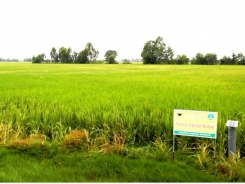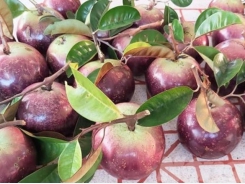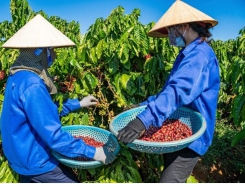Potential and advantages of raising beef and dairy cattle of Hanoi

Despite being a capital city, Hanoi has a lot of potential and advantages to develop cow husbandry thanks to large total areas in some districts and many riverside areas.
Hanoi authorities will issue many mechanisms and policies for cattle development. Photo: ST.
High demand
Hanoi capital city has a lot of potentials and advantages to develop cow husbandry thanks to large total areas in some districts and many riverside areas such as Ba Vi, Soc Son, Phuc Tho, among others.
Currently, the total number of cows in the whole city is 130,000, of which the dairy cows is 15,000. The city, with a population of over 10 million residents, is currently the largest center of food consumption in the Red River Delta and the northern area.
The demand for meat in the city is estimated at about 320 thousand tons/year, or nearly 900 tons/day. Meanwhile, livestock production of the city only meets about 60% of the demand and the rest must be imported from the vicinities or abroad.
In terms of beef, the city’s production output reaches over 10 thousand tons/year, only meeting nearly 20% of the demand. The output of fresh cow's milk reached 38.6 thousand tons, only meeting nearly 30% of the consumption demand of the city dwellers.
Such figures show that Hanoi has high demand for both beef and dairy products. In the past few years, in the context that breeding pigs and poultry has been greatly affected by epidemics, the development of cattle farming is expected to meet the requirements of restructuring the agricultural sector. It is also considered a strategic solution to realizing the goal of restructuring the agricultural sector, increasing income for farmers and gradually satisfying the demand for beef and dairy products of the capital residents.
Breakthrough
Before 2010, the program to improve the productivity and quality of livestock breeds in the city included about 149,000 cows, of which 7,700 were dairy cows and the rest were beef cattle and breeding cows. The cow breeds in this period mainly had low yield and quality.
Specifically, dairy cows produced less than 4,000 liters of milk per cycle. Meanwhile, Zebu crossbred cows (mainly Sind hybrid breeds) accounted for 70% of beef cattle and the rate of cows bred by artificial insemination method reached only about 34%.
Since 2011, thanks to the program of free artificial insemination of cows, new high-yield and high-quality cow breeds have been put into production in Hanoi. The quality of the herd has been improved significantly. The rate of artificial insemination on dairy cows reached 100% and beef cattle 80%.
Hanoi supplies the market with about 8,000 milk calves and 55,000 beef calves of all kinds yearly. Specifically, high-quality and productive beef cow breeds like Brahman, Droghmatterr, BBB, Charolai, Angus or Wagyu have been introduced into the crossbreed process. The average weight at the adult stage (24 months old) of the cows have also been significantly improved, reaching up to 650 kg per animal and increasing the meat rate from 43% to 63%.
In general, new breeds of cows have brought economic benefits to farmers from VND3 to 6 million VND/calf. In addition, the improvement of the cow herd with Brahman and Senepol cow semen is a premise for the application of high technology to breeding and producing beef breeds in Hanoi.
In terms of dairy cows, the technology for sex selection in the cattle has been applied to gradually improve milk productivity. The results showed that the percentage of female calves born from sex selection technology have reached 90%, producing about 5,500 liters of milk per animal each cycle (600 liters higher than the average milk yield of dairy cows born from the semen of normal dairy cows).
Thus, the technology has increased the efficiency by VND6 - 8 million per animal each cycle thanks to increased milk production.
Orientation for development
In terms of breeding cows, the development plan will focus on increasing their quality and weights of female cows by 10% compared to the present by applying artificial insemination between the local female cows with Senepol semen.
Meanwhile, the productivity and quality of beef cattle will also be enhanced by crossbreeding female cows with high quality cow semen (BBB, Chaorolais, Inra 95 ...). The weight of mature beef cattle (over 24 months old) will also be increased by 15-20%.
To dairy cows, the proportion of Holstein Friesian (HF) dairy cows will be increased in the direction asymptotically with purebred quality (milk cows with crossbreeding ratio 7/8 or more account for over 90%). Milk yield is expected to reach 5,500 kg/animal/cycle or more (equivalent to an increase of 10%/animal/cycle or more).
In addition, the potential and advantages of ecological zones adapting to climate change, large-scale commodity production, production in the direction of biosafety, food safety, and traceable products associated with the associated chain will also be promoted.
Such developments will therefore contribute to the implementation of the new rural program, improving the lives of farmers, ensuring social security and restructuring Hanoi's agricultural production in the direction of increasing added value, effective and sustainable development.
Key solutions
Some key solutions to uphold the potentials and advantages of raising beef and dairy cattle in Hanoi include:
Popularizing the information and providing technical training, particularly the city’s policies on seed support, environmental treatment, creating conditions for businesses to invest in building chain links.
Continuing to apply high technology in the field of livestock breeds, animal feed, livestock conditions, equipment for barns, and veterinary hygiene. Creating mechanisms and policies to attract businesses to invest in building a compound feed production facility exclusively for cows (TMR, TMF...).
At the same time, training the management team from the city level to the localities, especially the districts in the areas of developing dairy and beef cattle breeding to perform well the function of state management of breed, animal feed, and disease safety for cattle raising.
Training a team of skilled technicians on artificial insemination, gradually improving the level of expertise from artificial insemination to embryo transfer for future application; continuing to organize contests on skilled famers and productive cows to encourage enthusiam in the sector; connecting and attracting businesses to invest in high-tech cow farms and product consumption, in addition to building brands and product labels.
Strengthening trade promotion and chain linkage; developing the model of linkage chains in animal husbandry, slaughter, product processing and consumption; encouraging closed production organization, link between stages in the value chain to cut costs, increase efficiency and added value.
In addition, promoting trade in livestock products; closely coordinating with the Departments of Agriculture and Rural Development of provinces and cities in disease prevention and control, as well as product linkage and consumption. Particularly, closely associating with 10 provinces in the Red River Delta in supplying products to Hanoi and other provinces and cities.
Strengthening the inspection of livestock production facilities, preliminary processing and product processing facilities to enhance awareness of the Law on Livestock, the Law on Veterinary Medicine and the Law on Food Safety; strengthening disease surveillance for timely and thorough prevention, detection and handling to prevent the epidemics from spreading to large scale and minimize damage.
Focusing on guiding establishments to build disease-free facilities for dangerous infectious diseases that often occur in dairy and beef cattle like foot-and-mouth disease, skin rash...).
Changing the main livestock species to suit the region and ecological region, reviewing each livestock species to propose adjustments to suit the actual production development needs of each region and each market segment; effectively utilizing livestock waste sources to ensure disease safety and protect the environment.
Guiding livestock establishments and enterprises in the city to carry out animal husbandry according to national standards as prescribed.
Related news
Tools

Phối trộn thức ăn chăn nuôi

Pha dung dịch thủy canh

Định mức cho tôm ăn

Phối trộn phân bón NPK

Xác định tỷ lệ tôm sống

Chuyển đổi đơn vị phân bón

Xác định công suất sục khí

Chuyển đổi đơn vị tôm

Tính diện tích nhà kính

Tính thể tích ao




 Delighted with the new fiscal year's rice shrimp…
Delighted with the new fiscal year's rice shrimp…  VnSAT contributes to Vietnam's coffee industry's transformation
VnSAT contributes to Vietnam's coffee industry's transformation